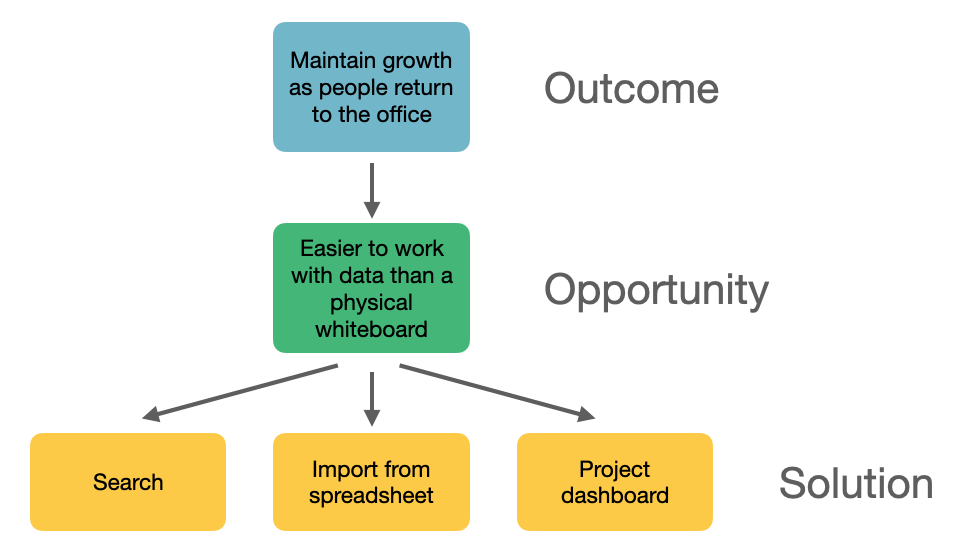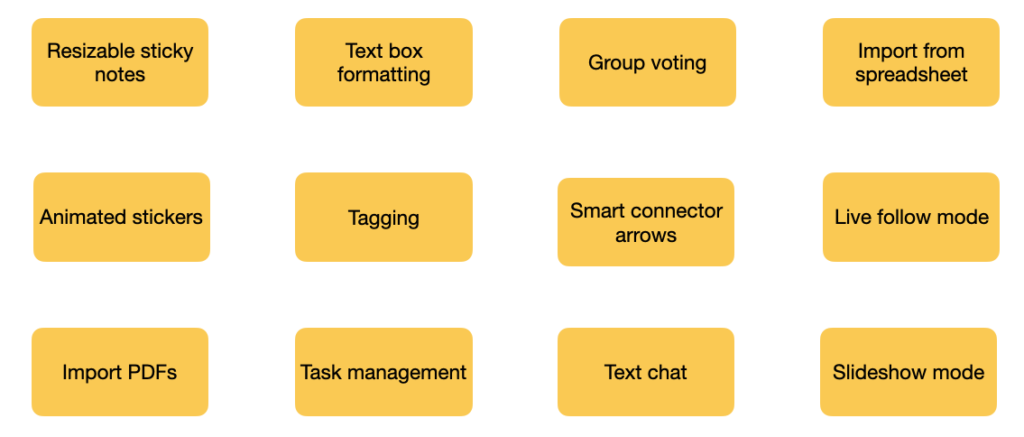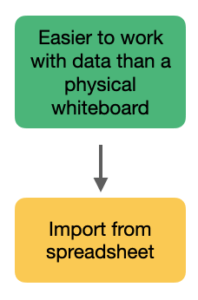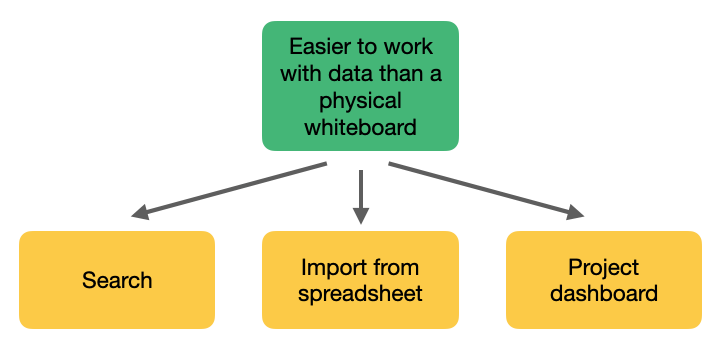
New software projects often come with a long list of potential features. How do you evaluate these ideas before investing costly resources into development? At SEP, we’ve been mapping potential features with opportunity solution trees. They are a way to visualize the relationships between ideas and their desired outcomes, and to manage the gaps in between. Creating these trees gives project teams insight into their options.
Let’s imagine we are building an online whiteboarding application. It starts like many projects I’ve been involved with – the client is excited that all their planning, budgeting, and coordinating has gotten them to kick-off. The rest of the project team is excited and ready to make something new. The client is considering the following features:

A big pile of features
It’s common to identify more features than can fit into a release. The team needs to choose a small set that will make the most difference. This is an easy place to lose momentum. Cutting or delaying precious ideas can be painful. I’ve had clients that have spent the months or years before the project setting a vision and making commitments to the rest of their company. Dropping features feels like putting those commitments at risk. The way out of this pain requires acknowledging that the current phase of the project doesn’t need to accomplish the entire vision, just the most useful next step. Identifying the next useful step requires a meaningful way to compare trade-offs.
The unprioritized backlog leaves the team with awkward unanswered questions, like:
- What features do we really need?
- How do these help the business and the users?
- Which ones do we do next?
- How do they fit into the larger vision?
The questions are hard to answer when the features are just collected in a big pile. And not only do you have too many features, you simultaneously are likely to have not considered enough features. How can this be? Behind each of the features is an implied need or opportunity. If these opportunities were clearly defined, you could think of more ideas to pursue them. That would allow you to compare your original idea with competing approaches.
A better mental representation
To get more clarity, we need a better mental representation. An opportunity solution tree provides this perspective.
Let’s consider one of the features from the pile: import items from a spreadsheet. The idea came about because a user had a customer feedback spreadsheet containing a list of comments. They would like to group the comments on a whiteboard to identify common themes. An import would allow them to instantly get these items into the online whiteboard. This is an opportunity to make the data much easier to work with – something that’s difficult on a physical whiteboard.

What are other solutions for that opportunity? These can be from the existing list, or new ideas.

Behind that opportunity is an outcome. After working remotely for two years, people are starting to return to the office. The client wants to keep their users engaged as people meet in person and have less need for remote working tools.

We now have the main components of the tree: outcomes, opportunities, and solutions. The outcome is a clear desired result you want to achieve. It’s often expressed as a metric. Opportunities are strategies for getting to the outcome. They are composed of user needs, pain points and desires. Solutions are the features you build to deliver on an opportunity.
With those components, what’s the approach for that initial big pile of unprioritized features?
Identify the outcome
First, what is the desired outcome for this phase of the project? Defining a good outcome can be difficult, especially if your projects have been managed by outputs. If your company uses OKRs you can start from there. If there is a large amount of ambiguity, make your best guess and define some provisional outcomes. Take those guesses and share them with your team members and stakeholders. Identifying a compelling outcome will allow you to align the team and the work to achieve it. It’s worth it.
On the other hand, you may be working on a project with multiple simultaneous outcomes. Which one is the priority? What are the trade-offs if one was the priority and the others were in supporting roles?
Add opportunities
Once you have an outcome, start adding opportunities. Each opportunity is a strategic approach for getting to the outcome. The opportunity should be from the user or customer’s point of view. Try to stay in the problem space by considering pains and desires rather than features and solutions.
If you start identifying specific things to build, then you’ve veered into identifying solutions rather than opportunities. That’s ok, just add the solution under the related opportunity and then return to the problem space.
Utilize discovery and problem definition here for a source of opportunities. This can be a good time to supplement your understanding of the problem with learning spikes or user research.
Connect and generate solutions
Now you can take the solutions and place them under the opportunities on your tree. Add new solutions as you think of them. It’s likely that some solutions from the original pile won’t show up in the tree. You are creating a representation of the solutions that will help you reach the desired outcome.
Adding opportunities and solutions happens iteratively. I’ll often build a little bit of a tree, get some more understanding, and then update descriptions and rearrange where items are placed.
Invest for outcomes
Our imaginary scenario around online whiteboards started with a backlog of unprioritized features. The initial perspective was: how can we pull from the backlog to produce the best outputs? However, the best outputs are the ones that lead to a desired outcome. An opportunity solution tree provides a structure to visualize that path.
Want more?
Opportunity solution trees were first introduced by product veteran Teresa Torres. You can read her excellent overview about them here.
I’ve used opportunity solution trees with large companies in finance, healthcare, and consumer products. Each time provided the team more clarity about their options, better understanding of the project’s vision, and an insightful visual aid for planning strategy with stakeholders.
How have you planned features around outcomes? Please reach out to me at [email protected]. I would love to hear how this has gone for you.